|
BLACK
BACKED GULL/Karoro
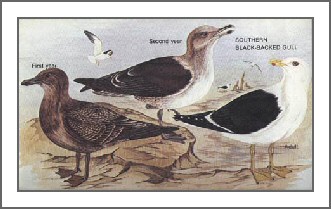
Black
backed Gull
Larus
dominicanus FAMILY: Laridae
Native,
circumpolar in southern temperate to sub-antarctic regions.
Not protected. Largest of the
three NZ gulls. First year birds a
mottled brownish-grey with dark bill. Found throughout
NZ on or near the coast, but wandering inland to
farmland and even alpine regions. Food
comprises any accessible animal food, often entirely
by scavenging. Commonly seen in large flocks
on dumps, riverbeds and fields. Breeding
is from
October to December. The nest is a bulky
structure of grasses and other plants, often pulled
up by the roots. Singly or in large colonies.
Eggs, usually 3, vary from light blue to
dark olive-brown with black and brown spots and blotches.
BLACK-FRONTED
TERN/Tara
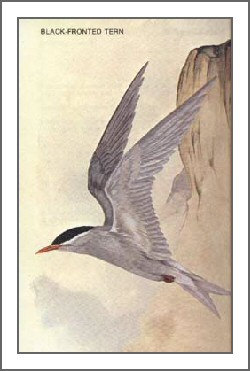
Black-fronted
Tern Chilidonias
hybrida
FAMILY:
Sternidae
Small
grey tern. Only breeding in the South Island,
inland on shingle riverbeds east of the main ranges.
They move to the coast in Winter, small
numbers making it to the North Island. Feeds
on small fish, water insects and larvae, caterpillars,
flying insects and moths. Commonly seen
following ploughs during cultivation of fields. Breeds
October to January, in a scrape in sand or shingle,
in loose colonies, sometimes with Black-billed Gulls.
Eggs, 1-3, vary from dark stone to brown
with large light and dark brown blotches all over.

CASPIAN
TERN/Taranui
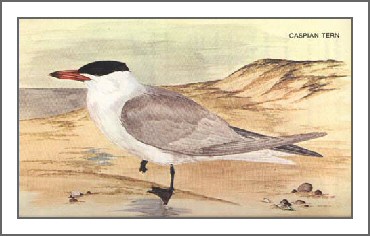
Caspian
Tern
Hydroprogne
caspia FAMILY: Sternidae
Native
and also found throughout the world in temperate and
tropical zone. Fully protected. Found
in the North and South Islands but more plentiful in
the north. They are usually seen singly
or in pairs along coastal estuaries and inland along
rivers. They feed on small fish by plunge
diving. Breeding is from September to January
the nest being a scrape in the sand or shingle on shingle
banks, sandy beaches and dunes, usually in colonies.
Some isolated nests can be found on rocky
promontories or inland near fresh-water lakes. The
eggs, 1-3, are light stone colour with dark brown blotches
and spots.

FAIRY
AND LITTLE TERNS
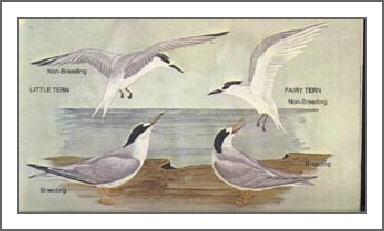
Fairy
Tern Sterna nereis FAMILY:
Sternidae
Native
and also found in New Caledonia and Australia. Fully
protected. Breeding plumage has a black eye-stripe reaching
half way between the eye and bill, forehead white. The
bill and feet are yellow. Very rare and
confined to North Auckland on sandy beaches where they
suffer from disturbance
by beach buggies etc. They feed on small
fish. Breeding is from November to January
and the nest is a scrape in the ground. The
eggs, 2, are light buff spotted with dark brown and
black.

Little
Tern Sterna albifrons FAMILY:
Sternidae Migrant
with several sub-species circumpolar in temperate and
tropical regions of the Northern Hemisphere, also SE
Asia and Australia. Fully protected. Same
size as the Fairy Tern. The breeding plumage
has an eye-stripe reaching the base of the bill. Bill
is yellow with a black tip. The 'non-breeding'
plumage is the same as the Fairy Tern
Little
Tern are rare but can be seen from October to June throughout
the country, more common in the north. Seen
in bays and estuaries and along open sandy shores. They
feed on small fish and crustacea. They breed
in the Northern Hemisphere from May to June, in Australia
from August to December. The nest is a scrape
in sand or shingle, in loose colonies. The
eggs, 2, are pale fawn-grey, blotched with brown and
black.

GREY
TERNLET
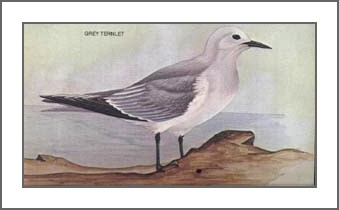
Grey
Ternlet Procelsterna cerulea
FAMILY: Sternidae Native
with various sub-species on tropical and temperate Pacific
islands. Fully protected. Smaller
than White-fronted Tern with black bill and legs. Feeds
by dipping the surface of the water while in flight,
or hovering. Short, slightly forked tail.
They are seen mainly in flocks, but rarely
seen close to mainland shores and the Hauraki Gulf.
They breed on Kermadec Islands and Volkner
Rocks near White Island, on rocky islets, in crevises
and under cover. They feed on marine invertebrates. Breeding
is from August to December. They nest on
bare ground under cover of rocks, vegetation, or small
niches and crevises in cliffs. The egg,
1, is light creamy-buff with reddish-brown spots and
blotches all over.

|
RED-BILLED
GULL/Tarapunga
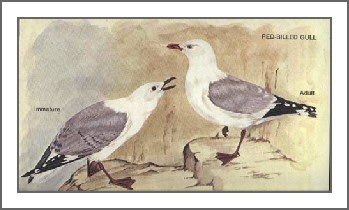
Red-billed
Gull
Larus
novaehollandiae FAMILY: Laridae
Native,
also found in Australia and Sth Africa. Fully
protected. Found throughout NZ on coasts
and off-shore islands, sometimes inland and often in
large flocks. Feeds on crustacea, small
fish, worms, berries and scavenged dead animal matter.
Breeding is from October to December.
The
nest is of seaweed, grasses and ice plant, in close
colonies from a few to thousands of birds, on
islands, rocky headlands, beaches and cliffs. The
eggs, 2-3, are variable grey to brown with light and
dark blotches all over.

BLACK-BILLED
GULL/Tarapunga
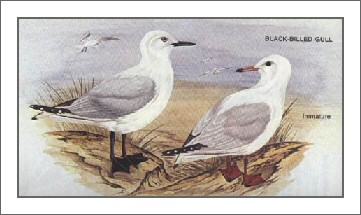
Black-billed
Gull Larus
bulleri
FAMILY: Laridae
Endemic
and fully protected. Breeding mainly in
the Sth Island on large shingle river beds. They
are uncommon in the Nth Island but there are regular
colonies at Rotorua, Poverty Bay and Hawke's Bay.
After
breeding birds move to the coast with a northward movement
across Cook Strait. They
feed on aquatic and land insects and they are often
seen in freshly ploughed fields and scavenging in towns
during Winter.
Breeding
is from October to December, with nests of plant matter
and grasses, in tight colonies. Eggs,
2-3, are similar to the Red-Billed Gull, but lighter
in colour.
 WHITE-FRONTED
TERN/Tara
WHITE-FRONTED
TERN/Tara
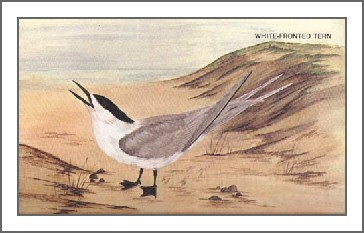
White-fronted
Tern Sterna striata
FAMILY:
Sternidae
Endemic and fully
protected. Size between the Caspian and
Black-fronted Terns, with deeply forked light grey tail,
large black cap and white stripe on the forehead. Young
birds have a mottled cap with the back and wings barred
with black stripes. Found throughout NZ
mainly on the coast. Many juveniles cross
the Tasman and spend at least their first winter
on the East Australian coast. They feed
mainly on shoaling small fish by plunge diving from
the air. Breeding is from October to January,
and nest on bare rock or a scrape in sand or shingle,
sometimes of grasses, twigs and ice-plant. They
are seen in colonies of a few to several hundred and
are often associated with Red-billed Gulls. The
eggs, 1-2, are variable light stone, green or brown
with small scattered dark and light brown blotches.

WHITE-WINGED
BLACK TERN
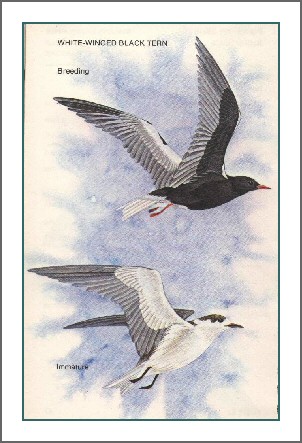
White-winged
Black Tern
Chlidonias
leucopterus FAMILY:
Sternidae
A visitor from
Central Europe and Central Asia. Fully protected.
Same size as Black-fronted Tern and both
breeding and immature (non-breeding) birds can be seen
at any time of year. These birds hawk for
insects low above standing water and flooded paddocks.
They are very rare but may be seen throughout
both islands on coastal lagoons, marshes and estuaries
and inland over standing water. There was an unsuccessful
attempt to breed them in South Canterbury early in 1974.
They breed from May to July in the Northern
Hemisphere. The nest is usually large
and floating, made of reeds and grasses set in sparse
vegetation. The eggs, 2-3, are pale brown
with darker blotches.

NEW
ZEALAND DOTTEREL
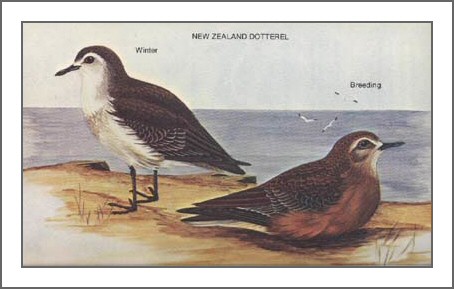
New
Zealand Dotterel Charadrius
obscurus
FAMILY:
Charadridae
Larger
and higher than the Banded Dotterel. The
breeding plumage is a rich rusty-fawn with the male
more colourful and the female lighter. Small
flocks can be seen in late Summer. They
are very tame birds, but will perform a 'broken wing'
distraction display in the breeding season. These
birds are rare and localised. There are
two separate continuous populations; one in the South
Island on the Southland coast and Stewart Island, and
one in the North Island from North Cape south to Kawhia
and East Cape. They are found on sandy and
shelly beaches or dunes by the ocean or estuaries, and
grassy paddocks near the sea in Winter. They
breed up to 600mt on Stewart Island and feed on small
shellfish, insects and crustacea. Breeding
is from August to February and the nest is a scrape
in sand or shingle, or among low vegetation, on Stewart
Island. The eggs, 3, are buff or olive,
heavily blotched with black or brown.

|





























